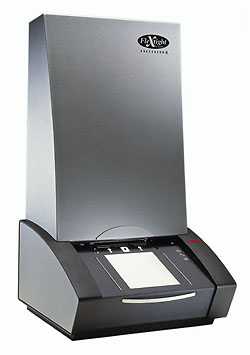Types of Scanner
At the university we have three types of scanner. We have flat bed scanner, a drum scanner and a imacon scanner.
Flat Bed - 'Epson V750 Pro'
Flat Bed - 'Epson V750 Pro'
- The flat bed scanner is reasonably easy to use.
- The top half of the scanner is what scans the film.
- It can scan 35mm, medium format, 5x4 and 10x8 film
- reflective and transparency scanning
- Quality of scan for 5x4 is near enough the same as the imacon, but not as good for 35mm and medium format
- Has a CCD sensor (Charged Couple Device) that interprets the colour based on the sensor chip. This should be calibrated for the best scan.
The scanner sensor make a pass over / under a fixed object and contains mirrors and/or lenses to reflect the beam to the analogue/digital converter. - The optical path of the sensor is impure and a degree of interpretation is made by the sensor. The optical path is more of a criss cross action rather than straight down.
- has anti newton rings glass - the pro version such as this has better glass (only to be cleaned by technicians)
- dual lens
- sometimes the film may not be completely flat - when the film gets warm is can get a big saggy and not fit perfectly into the film holder
- Uses Epson software to scan - it works and is simple but has less options than the software used with the Hasselblad scanners.
Imacon Flextight Precision II & III
- Hasselblad scanners
- Transparency scanning (negative and positive only)
- Optical path is vertical - the height of the scanner allows this.
- No glass between the sensor and the film - no chance of Newton Rings
- Cannot scan 10x8
- Negative holders are magnetic, keeping the film flat. Additionally, it's fed into the scanner on a slight curve which also ensures the film remains flat.
- Unfortunately it can suck in a lot of dust - wear clothes that aren't fluffy and blow off any dust on the film!
- Will sharpen your image even when you don't apply the sharpen option.
- Can hire these scanners in cities like london for a limited time
- £16,000 to replace
- At the university we use silverfast software with this type of scanner which has many more options than the software we use the the flatbed scanners
Drum Scanner - Linotype-HELL Cromagraph S3400
- The drum scanner we have at the university was made in Germany in 1997, and was bought for $70,000
- Weighs 350 kilos
- It's locked in time - we cannot update it.
- 18,000 DPI scans - super high quality - this can be a negative factor too, as in suffolk we have hard water and when we develop their may be tiny specks of limescale on our film - the drum scanner will be able to pick this up in the scan! Also any dust will be very visible
- Scans as 48 bits (16 bits per channel)
- Reflective and transparency scanning
- Highest DMax of any scanner - resolves shadow detail
- Uses limited version of Silverfast AI with most features not available
- Vastly superior tonal ranges
- £10 per large format scan at the university, can be up to £100+ elsewhere for a single scan.
- Takes longer to scan a 35mm negative than a 10x8 negative
- Annual service cost of £500
- Use for exhibition quality prints
- Film is mounted into a glass cylinder by the technicians
- Can take a long time to do
- In the middle of the cylinder there's a sensor that allows the light to be split into three different beams. Each beam is sent through a colour filter into a photomultiplier tube where the light is changed into an electrical signal.
- Because of the far superior quality, if you need to blow up an image to a large size, such as for advertising campaigns, this is what you would use. The other types of scans would be too grainy and this would give a afar sharper outcome.
What are Newton Rings?
According to Lomography;
"Newton’s rings usually form due to interference created by reflection of light from a flat surface onto a spherical surface. In scanners moisture on either the negative or on the glass surface (the tiny spherical droplets of moisture are responsible for the concentric rings in the pattern) can result in this problem."
They appear almost like fingerprints. They can really affect the quality of your print. To avoid this, you can get anti newton ring glass such as we have on the flat bed scanner at university.
https://www.lomography.com/magazine/158256-how-to-avoid-newton-rings-while-scanning-your-negatives
According to Lomography;
"Newton’s rings usually form due to interference created by reflection of light from a flat surface onto a spherical surface. In scanners moisture on either the negative or on the glass surface (the tiny spherical droplets of moisture are responsible for the concentric rings in the pattern) can result in this problem."
They appear almost like fingerprints. They can really affect the quality of your print. To avoid this, you can get anti newton ring glass such as we have on the flat bed scanner at university.
https://www.lomography.com/magazine/158256-how-to-avoid-newton-rings-while-scanning-your-negatives






Comments
Post a Comment